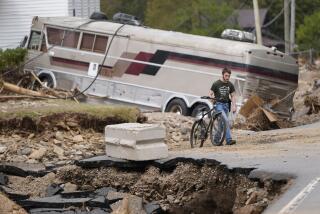Tears Over the Enormity of It All
- Share via
PUNTA GORDA, Fla. — As survivors of Hurricane Charley sweated through another day without power or running water Monday, authorities warned of a second wave of casualties caused by heat stroke, generator fumes and psychological trauma.
“We ask people to understand that they need to take care of themselves,” said Wayne P. Sallade, director of emergency management services for Charlotte County.
On Monday, thousands waited in line for portable toilets and drinking water and sifted through ruined possessions. Many dissolved into tears at the thought of what had happened.
“People start crying because now they have a clean, dry place and a hot meal. It’s been traumatic, obviously,” said Don Walker, manager of a shelter in North Port on Charlotte Harbor. “Most of them have lost everything.”
Dr. Jerry Ross, head of Charlotte Community Mental Health Services, said thousands of survivors were likely to experience flashbacks, sleeplessness and a decline in function. “What is going to happen is, as the basic needs get met, people will start to realize the trauma that they are experiencing,” Ross said.
Three days after the storm, its costs came into focus. On its diagonal trip across Florida on Friday, Hurricane Charley killed at least 17 people and caused between $5 billion and $14 billion in damage, according to industry estimates.
Susan Pareigis, director of the state Agency for Workplace Innovation, said as many as 120,000 Floridians could have lost their jobs due to the storm, and she recommended that they file for unemployment benefits.
Across the state, 890,000 people were still without power Monday, officials said. Gasoline was hard to come by, phone service was patchy and more than 2,000 people remained in emergency shelters.
With the search for victims slowed by downed power lines and felled trees, officials could not give an accurate count of the number of people missing. Search and rescue efforts ended Monday in Charlotte County, leaving the death count at four, a figure far lower than expected, Sallade said.
“The fact that we have not found any more dead than we have is nothing short of a miracle,” said Guy Tunnell, chief of the Florida Department of Law Enforcement.
Still, major problems face officials. In Charlotte County alone, 70,000 homes are without electricity. So many transmission lines and poles were toppled that the county’s whole power network needs to be rebuilt, said Ben Wesley, external affairs officer for Florida Power & Light. Managers expect to have a clear sense today of how long the job will take, he said.
If improvements aren’t made soon, the stress of the conditions -- especially the power outage -- could lead to civil unrest, said Charlotte County Sheriff Major John Davenport, who announced a 9 p.m. to 6 a.m. curfew. He said some looting had taken place in Punta Gorda.
“Tempers are starting to flare,” Davenport said. “Utilities are the big thing -- power, air conditioning, water. People need to have these basic comforts.”
By Monday, 5,000 people -- utility workers, aid workers and law enforcement officers -- had arrived in Florida to help with reconstruction, Sallade said.
“We’ve got a long way to go on the street, but we have turned a corner,” he said.
The need is so massive, he said, that “Mom and Pop out there on Edgewater Drive in Port Charlotte may feel that little, if anything, is being done for them.”
Sallade said a new wave of injuries could result from cleanup efforts -- people falling off roofs, cutting themselves with chain saws or overexerting themselves in the storm’s aftermath.
“The emergency systems are already stretched,” said Dick Kane, spokesman for the state Emergency Operations Center in Tallahassee. “If people are clearing debris in their yard, and suddenly have a chest pain or contraction, they need to stop. If necessary, they should seek help immediately.”
Several people in Lee County, to the south, have already fallen victim to carbon-monoxide poisoning from diesel-powered generators they brought inside, said David Kainrad, a state emergency services spokesman. One person died and 12 were evacuated after being exposed to carbon monoxide, he said.
“These things need to be vented,” Kainrad said. “People just aren’t thinking.”
Small comfort came when weather forecasters reported that two developing storm systems, Danielle and Earl, were unlikely to come anywhere near Florida. Forecasters have predicted an unusually severe 2004 hurricane season, and Charley confirmed those fears, causing more damage than any storm since Hurricane Andrew in 1992.
Dahlburg reported from Punta Gorda and Hart from Houston. Times staff writer Ellen Barry contributed to this report.
More to Read
Sign up for Essential California
The most important California stories and recommendations in your inbox every morning.
You may occasionally receive promotional content from the Los Angeles Times.










